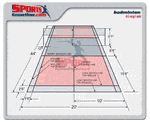From Party Game to Serious Sport
Nearly anyone can pick up a lightweight badminton racket and hit the shuttlecock over the net. Because it’s an easy game for beginners, badminton remains popular at picnics and parties. But badminton is deceptive. It is the fastest of all the racket sports. A powerfully hit shuttle can travel as fast as 200 miles per hour. At the elite levels, the game requires amazing speed, strategy, leaping ability, power and quickness. A player can run as much as a mile during a match.
As the best players moved from the lawns and salons to competitive courts, they naturally wanted to compete against other top athletes. The All-England Championships gave them this opportunity. By 1938, players from other countries began to compete in this tournament. An American woman, Judy Hashman, won 17 all All-England titles—the most of any player in history.
More tournaments and competitions became available as the sport continued to attract more competitive players. In 1939, Sir George Thomas donated the Thomas Cup, a trophy to be awarded at the International Badminton Championship for the top men’s singles players. (Badminton can be played by men or women in singles and doubles competition, and by teams of mixed doubles.) Thomas was a British lawn tennis champion who switched to badminton and won 90 tournament titles over 24 years. Thomas was also the first president of the IBF.
In 1949, the Thomas Cup became a men’s world team championship competition much like the Davis Cup in tennis. In 1956, the Uber Cup competition was created for women. Betty Uber of England, one of badminton’s top doubles players, donated the trophy. See a list of Thomas and Uber Cup winners below. Initially, the Davis and Uber Cup Competitions were played every three years. Since 1982, international team championships have been every two years—in even-numbered years. In odd-numbered years, individuals compete for international honors.
Four Square Championships
2012 Four Square Champions
Div. I (ages 13-39) men's champ - Mark Pryor
Div. I women's champ Brittany Dunay
Div. II (40 and up) men's champ Billy O'Connor
Div II women's champ - Molly Froelich
Team champions “The Raging Narwhals”
2011 Four Square Champions
Div. I men's champ Mark Hirsh
Div. I women's champ Christina Laverentz
Div. II men's champ Ted Tivoli
Div II women's champ - Sue Grodberg
Team champions “The Raging Narwhals”
2010 Four Square Champions
Div. I men's champ Christian Housh
Div. I women's champ Corey Carmichael
Div. II men's champ Tom Stockwell
Div II women's champ Audrey Castro
2009 Four Square Champions
Div. I men's champ Chris Glasser
Div. I women's champ Justine Petrillo
Div. II men's champ Tom Stockwell
Div II women's champ Audrey Castro
Team champions “The Mauve Avengers”
Uber Cup Winners
| Year | Champion |
| 1957 | United States |
| 1957 | United States |
| 1960 | United States |
| 1963 | Japan |
| 1966 | Japan |
| 1969 | Japan |
| 1972 | Indonesia |
| 1975 | Japan |
| 1978 | Japan |
| 1981 | China |
| 1984 | China |
| 1986 | China |
| 1988 | China |
| 1990 | China |
| 1992 | Indonesia |
| 1994 | Indonesia |
| 1996 | China |
| 1998 | China |
| 2000 | China |
| 2002 | China |
| 2004 | China |
| 2006 | China |
| 2008 | China |
| 2010 | Korea |
| 2012 | China |
| 2014 | China |
| 2016 | China |
Today, the world’s very best badminton players compete professionally for prize money. Television contracts and sponsorships have dramatically increased the winnings available on the pro badminton circuit.
Asia Dominates the Sport
Though England birthed the sport of badminton, it has been Asia that adopted it as its own. China and Indonesia are the two dominant nations in international badminton competition. Matches in these nations draw crowds of more than 15,000. These two countries together have won an astonishing 70 percent of all IBF events. Asian countries have claimed all 23 Thomas Cups that have been awarded. In Uber Cup competition, Asian nations have won the last 15 titles.
The Olympics have been another showcase for Asian badminton prowess. Badminton was played as a demonstration sport at both the 1972 and 1988 Olympic games. In 1992, medal competition began in men’s and women’s singles and doubles. Mixed doubles was added in 1996. Of the 61 medals awarded in Olympic badminton, Asian countries have won all but seven. The chart below clearly shows their dominance.
Olympic Badminton Medals
| Country | Gold | Silver | Bronze | Total |
| China | 11 | 6 | 13 | 30 |
| Indonesia | 6 | 6 | 6 | 18 |
| Korea | 6 | 7 | 4 | 17 |
| Malaysia | - | 2 | 2 | 4 |
| Great Britain | - | 1 | 1 | 2 |
Outside of Asia, the Scandinavian countries have the strongest badminton programs. Six times, Denmark has finished second in Thomas cup competition. Interest in badminton, primarily in these two parts of the world, make it the world’s second most popular sport behind soccer.
